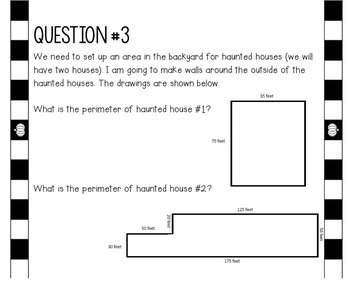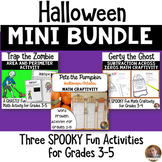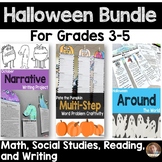Halloween Math Activities & Craft | Differentiated Word Problems
- PDF
What educators are saying
Also included in
- Engage your students in multi-step word problems like never before with these math crafts for the entire year. Each of the 16 math craftivity activities will have your students working on multi-step word problems to help students practice and improve important problem solving skills. Each one of thPrice $25.00Original Price $71.50Save $46.50
- This pack includes our top 8 Halloween Math resources: Gerty the Ghost Subtraction Across Zeros Craftivity, Pete the Pumpkin Word Problem Activity, and Trap the Zombie Area and Perimeter! Thanks for looking,Dan M.Price $17.50Original Price $32.00Save $14.50
- Looking for a few fun Halloween and October materials for your students? This pack includes 7 projects for your students in grades 3-5. There is social studies, reading, writing, and math included in this bundle of 7 activities. This is great for the weeks leading up to Halloween when things get a bPrice $16.00Original Price $31.75Save $15.75
Description
Looking for a fun Halloween math activity that’s easy to differentiate? This Halloween math activity is perfect for 2nd, 3rd, 4th, and even your 5th grade students! Pete the Pumpkin needs some help getting ready for a Halloween party he is throwing! Students will complete 5, engaging Halloween themed, multi-step word problems before creating their own pumpkin craft. This Halloween math project is differentiated for grades 2-5 and is perfect for the days or weeks leading up to Halloween!
⭐ Looking for more fun Craftivities? Check out the Craftivity Bundle!
Halloween Math Activities & Craft | 2nd - 5th Grade Differentiated Word Problems Includes:
- 4 Different Word Problem Versions for Grades 2-5
- Pete the Pumpkin craft pieces
- Directions
Word problems for second grade version include:
- Addition up to and including 100's
- Adding 3 and 4 numbers at a time,
- Perimeter
- Using a table to solve addition problems.
- Two-step word problems
Word problems for third grade version include:
- Subtraction and Addition up to and including 1,000s.
- Estimating
- Perimeter
- Multi-step problem solving using money.
Word problems for the fourth and fifth grade edition include:
- Subtraction and Addition up to and including 1,000s.
- Estimation
- Perimeter
- Multi-step problem solving using money.
See What Other Teachers Are Saying . . .
⭐ My students really enjoy these math activities. They are engaging and also educational. They also look forward to completing them and seeing their work displayed in the hallway.
⭐ An amazing resource that keeps the students completely engaged! The loved solving problems to help Pete the pumpkin!! They even make great a great display for our bulletin board!
⭐ I used all 3 grade levels in my 4th grade classroom to adjust for the learning needs. My students really enjoyed this activity, and were astounded by how tall their Pete the Pumpkin was when finished.
More Fun and Engaging Resources from Mr. Mault’s Marketplace:
- Halloween Activities BUNDLE
- Halloween Around the World Social Studies Activities
- October Digital Would You Rather Prompts
⭐ Follow Me to be notified when new resources are added. ⭐
Find more on the Website | Connect with me on Instagram | Follow on Facebook








